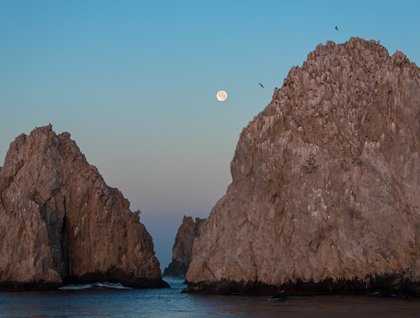The full moon slipped lower in the inky dawn sky as we approached the rugged rocks of Land’s End near Cabo San Lucas. As frigatebirds soared overhead, the rising sun began to bring out the highlights of ruddy tones in these craggy cliffs. Captain Kay brought the ship’s bow ever closer towards the famous arch, and the bark of sea lions echoing off the rocky walls surrounded us in a lovely background soundtrack. It was a stunning start to a full day.
We repositioned to San José del Cabo for our various morning onshore explorations. With plenty of options to choose from, some headed off to walk the verdant estuary path for bird watching, while others headed into town for a glassblowing demonstration, and a few went off to discover the town on their own. The town of San José del Cabo has a pretty central area—primarily a tourist destination, yet sleepy in comparison to the nearby bustling metropolis of Cabo San Lucas—with its lovely cathedral, a bustling arts and crafts area, and plenty of shopping opportunities.
The second half of our day was far different from the “civilized” morning in town. We headed out into the Sea of Cortez on calm, windless seas to look for marine mammals. It wasn’t long until the dedicated folks on the bow and bridge found whale blows ahead. We had multiple sightings of humpback whales, first spending a bit of time watching a cow and calf pair with a third whale, presumably a male “escort.” During the afternoon there were more blows to be seen, many raised flukes to photograph, and a distant breach or two.
As the afternoon progressed, we were lucky to discover a few special sightings. Numerous sea turtles were seen basking on the surface, and a hammerhead shark was spotted off the bow and those on deck had a chance for a glimpse or two as it swam past. Even more exciting, unexpected, and a first-time sighting for the many repeat Baja visitors in the group (and most of the staff), was finding a group of perhaps nine rough-tooth dolphins. These dolphins are very unusual to find in these waters, though are normally seen farther south in Mexico. The rough-tooth dolphin’s presence off the Baja California peninsula this year is likely the result of warmer El Niño water temperatures. We had terrific views as these dolphins swam leisurely around us, even lazily bow-riding the slow-moving National Geographic Sea Bird. It was great to get such up close looks of them, the unusual slope of their head to beak, and the pinkish color of their lower jaw is quite distinctive.
We continued our journey, angling north towards the islands and adventures that lay ahead.






